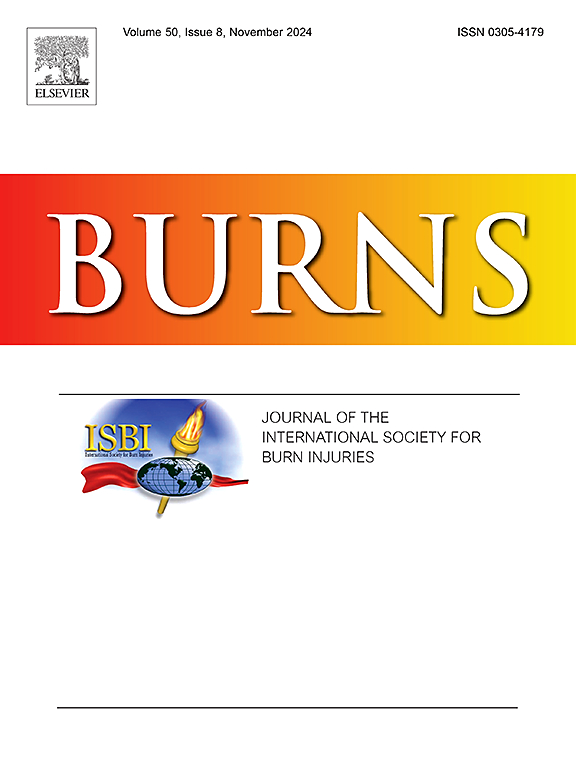Long-term health-related quality of life after a deep second- or third-degree burn treated with skin grafting
IF 3.2
3区 医学
Q2 CRITICAL CARE MEDICINE
引用次数: 0
Abstract
Background
As burns are known to have a negative impact on the burn victim’s quality of life, the health-related quality of life (HRQoL) is a key outcome in the evaluation of burn treatment. In recent years there has been increasing interest in the use of HRQoL instruments after burn injury. The aim of this study was to assess whether there is a correlation between the HRQoL and the total body surface area (TBSA)% burned and also to assess correlation between the SCAR-Q scores and the TBSA% burned in deep burns requiring skin grafting.
Methods
Participants were adult burn patients treated in the Helsinki Burn Centre between 2006 and 2017 with skin grafting after deep second- or third-degree burns. Participants completed the general HRQoL 15D instrument and the patient-reported scar outcome measure SCAR-Q.
Results
194 participants were divided into three groups according to the burn TBSA%: small burns (<10 %), moderate burns (10–20 %) and large burns (>20 %). The total HRQoL score after small burns did not differentiate from the reference population, even though there was a statistically significant difference in two domains (depression and distress). HRQoL measured with the 15D instrument was worse for moderate burns in half of the domains and for large burns in most of the domains (11/15) in comparison with the reference population. Small burns scored the best and large burns the worst in every SCAR-Q subscale.
Conclusion
There is a negative correlation between both the HRQoL and SCAR-Q scores in relation to the burn size in deep second- and third-degree burns. Small deep burns did not appear to affect the total HRQoL, but with moderate and large deep burns the HRQoL was impaired.
皮肤移植治疗深度二度或三度烧伤后的长期健康相关生活质量
背景:众所周知,烧伤会对烧伤患者的生活质量产生负面影响,健康相关生活质量(HRQoL)是评估烧伤治疗的关键结果。近年来,人们对烧伤后HRQoL仪器的使用越来越感兴趣。本研究的目的是评估HRQoL与烧伤的总体表面积(TBSA)%之间是否存在相关性,以及评估需要植皮的深度烧伤中SCAR-Q评分与烧伤的TBSA%之间的相关性。研究对象为2006年至2017年在赫尔辛基烧伤中心接受深度二度或三度烧伤植皮治疗的成人烧伤患者。参与者完成了一般HRQoL 15D仪器和患者报告的疤痕结局测量scar - q。结果194例受试者按烧伤TBSA%分为3组:轻度烧伤(<10 %)、中度烧伤(< 20 %)和重度烧伤(>20 %)。小烧伤后的总HRQoL评分与参考人群没有差异,尽管在两个领域(抑郁和痛苦)存在统计学上的显著差异。与参考人群相比,15D仪器测量的HRQoL在一半区域的中度烧伤和大多数区域的大面积烧伤(11/15)中更差。在每个SCAR-Q分量表中,小烧伤得分最高,大烧伤得分最低。结论深二、三度烧伤患者HRQoL和SCAR-Q评分与烧伤面积呈负相关。小深度烧伤似乎不影响总HRQoL,但中度和大深度烧伤的HRQoL受损。
本文章由计算机程序翻译,如有差异,请以英文原文为准。
求助全文
约1分钟内获得全文
求助全文
来源期刊

Burns
医学-皮肤病学
CiteScore
4.50
自引率
18.50%
发文量
304
审稿时长
72 days
期刊介绍:
Burns aims to foster the exchange of information among all engaged in preventing and treating the effects of burns. The journal focuses on clinical, scientific and social aspects of these injuries and covers the prevention of the injury, the epidemiology of such injuries and all aspects of treatment including development of new techniques and technologies and verification of existing ones. Regular features include clinical and scientific papers, state of the art reviews and descriptions of burn-care in practice.
Topics covered by Burns include: the effects of smoke on man and animals, their tissues and cells; the responses to and treatment of patients and animals with chemical injuries to the skin; the biological and clinical effects of cold injuries; surgical techniques which are, or may be relevant to the treatment of burned patients during the acute or reconstructive phase following injury; well controlled laboratory studies of the effectiveness of anti-microbial agents on infection and new materials on scarring and healing; inflammatory responses to injury, effectiveness of related agents and other compounds used to modify the physiological and cellular responses to the injury; experimental studies of burns and the outcome of burn wound healing; regenerative medicine concerning the skin.
 求助内容:
求助内容: 应助结果提醒方式:
应助结果提醒方式:


